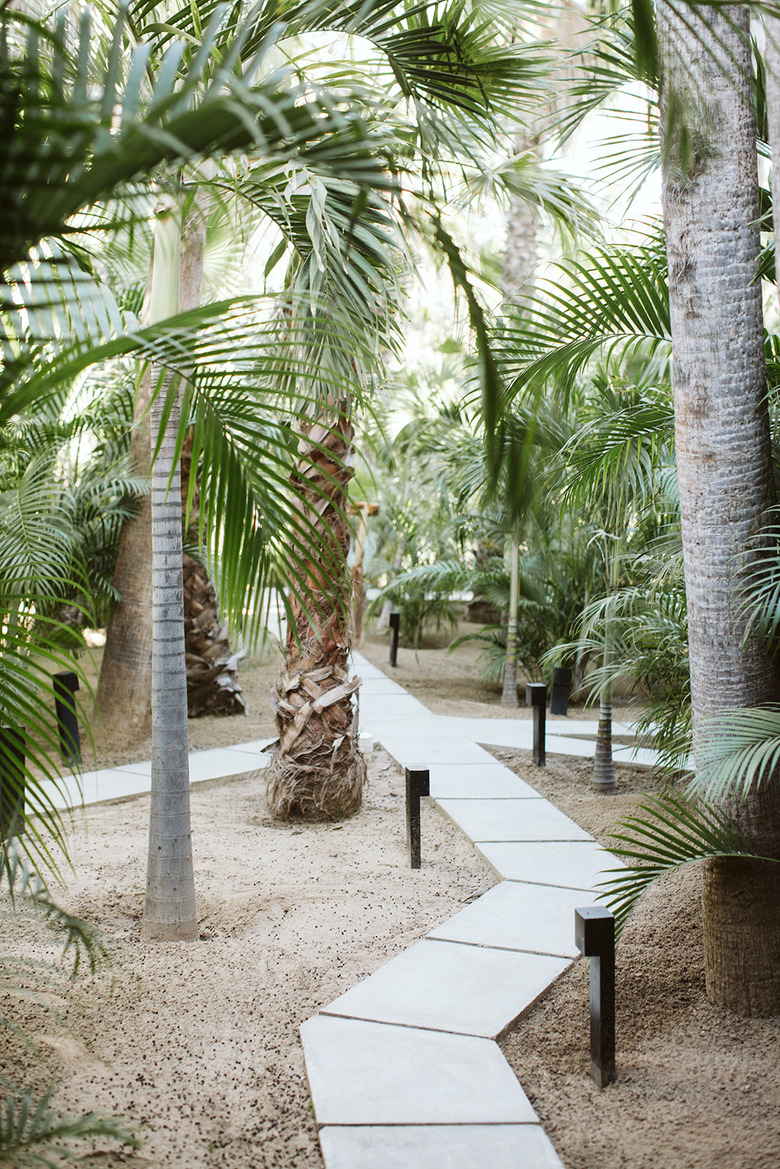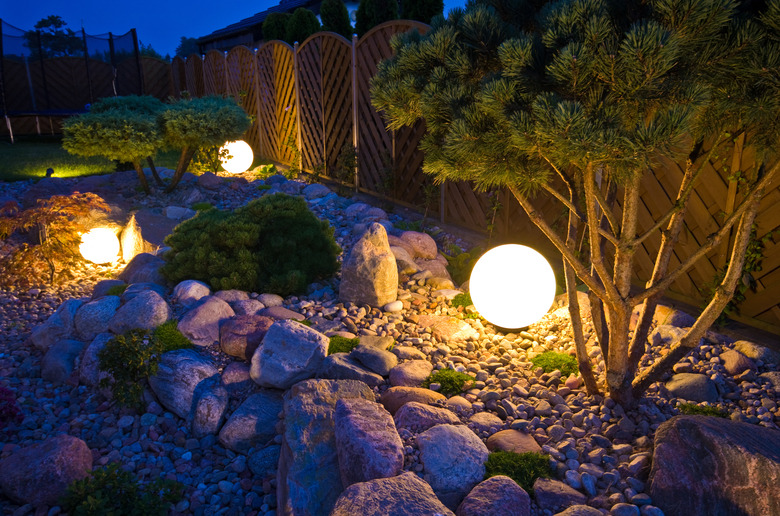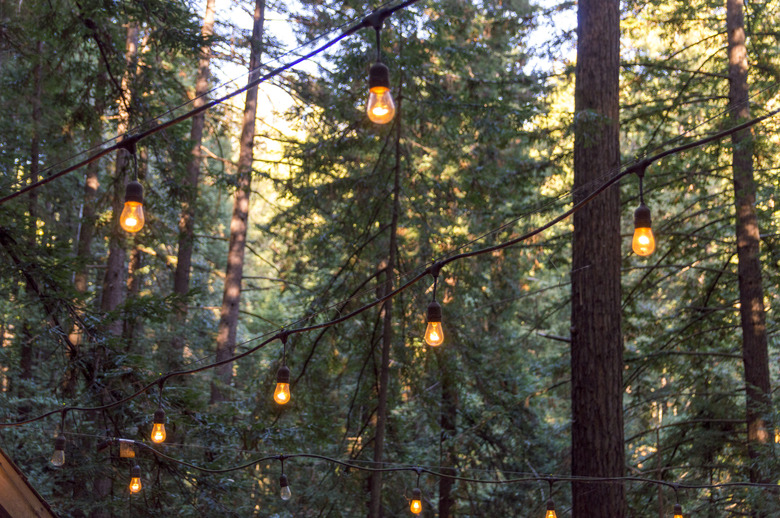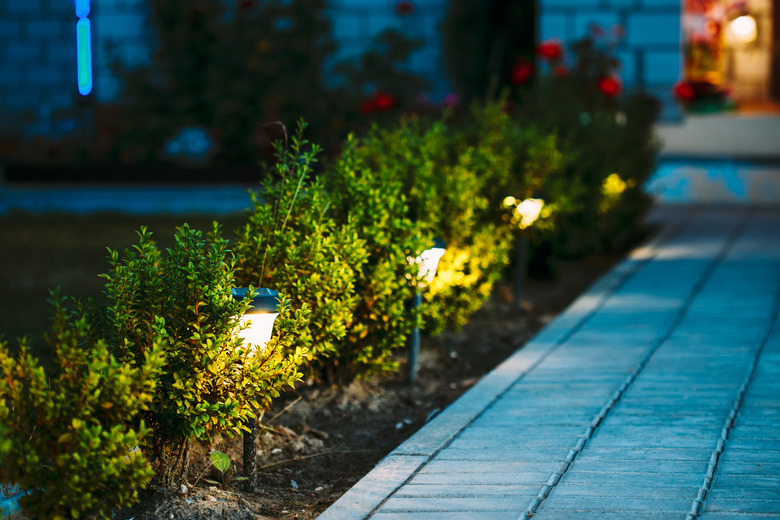A DIY Guide To Landscape Lighting Design
We may receive a commission on purchases made from links.
When the sun sets on your lawn and garden, landscape lighting can give it even more appeal than it has during the day. Choosing from a host of landscape lighting ideas, you can draw attention to your flower beds, highlight your most dramatic trees, line the walkways for easier night-time navigation, bathe the house in soft illumination, focus on a distinctive architectural feature — the list goes on. The best part is that you can do all this yourself as a DIY project as long as you don't mind doing a small amount of digging.
Unlike indoor lighting fixtures, which operate at line voltage, or 120 volts (give or take a few volts), outdoor lighting fixtures are low-voltage and require only one-tenth of that, or 12 volts. You can supplement these with solar lighting fixtures, although for a number of reasons, it's best not to expect solar lights to supply all your exterior lighting needs. Low-voltage fixtures are reliable, easy to install and maintain and cost about $320 per fixture for professional installation, according to data from Inch Calculator. The cost is a fraction of that if you do the work yourself, however.
Landscape Lighting System Components
Landscape Lighting System Components
The main components of a landscape lighting system are a low-voltage transformer to step the line voltage down from 120 volts to 12 volts; the lighting fixtures, each of which consists of a housing and a bulb; and wires to connect the fixtures to each other and to the transformer. Because low-voltage electricity isn't dangerous, the wires can be buried without conduit. The best gauge to use depends on the overall length of the circuit because the voltage drop over longer distances is minimized if you use wire with a smaller gauge number. Wire gauge is a measure of its thickness; a lower gauge number corresponds to a thicker wire, and thick wire offers less resistance to electricity flow than thin wire. Landscape wire in 10 or 12 gauge is recommended by 1000 Bulbs.
The transformer must have a large enough wattage rating to handle all the fixtures. You size the transformer by adding the power draw of all the fixtures and adding a little extra to allow you to add more fixtures in the future. LED bulbs, which have largely replaced more power-hungry halogens, typically draw about 12 watts each, so a system that includes 10 such fixtures would need a 120-watt transformer at a minimum. However, you should multiply the total draw by 1.25 to account for cable distance, so the actual minimum transformer size would be 150 watts, and to allow for more fixtures in the future, you'd probably want to upgrade to a 200-watt transformer.
Landscape lighting fixtures come in various styles and serve several purposes:
- Wash lights send out broad, diffuse lighting for illuminating walls, hedges and other large areas.
- Bullet lights provide a bright, focused beam for illuminating individual trees or architectural features.
- Flood lights are as bright as bullet lights, but the lighting pattern is wider and can take in more of the landscape.
- Down lights have brackets that can be attached to tree branches or fence posts and provide downlighting from above.
- Well lights, which are great for illuminating tree branches or a house facade, are buried and send a vertical beam straight up from the ground.
- Path and garden lights usually have an opaque canopy that shades the light so only the ground in the immediate vicinity of the fixture is illuminated.
Designing a Landscape Lighting System
Designing a Landscape Lighting System
It's best to establish your lighting goals and draw up a lighting plan before you begin installation. The plan should take into account the electrical needs of the fixtures themselves as well as the illumination patterns that best suit your property.
Typical spacing between fixtures should be 8 to 10 feet, and no fixture should be closer than 10 feet to the transformer to avoid overloading that fixture. Moreover, to prevent voltage-drop issues, avoid creating runs longer than 100 feet by branching off circuits in different directions from the transformer, which should ideally be centered in the lighting network.
Illumination patterns depend on whether you want to highlight house or garden features to improve the curb appeal of the property, create atmosphere for your garden or patio or provide safety lighting on walkways, decks and stairs. Possibilities include:
- Providing atmospheric lighting for trees, walls or other features using bullet, wash or flood lights. You can also hang downlights in tree branches to illuminate a seating or garden area from above.
- Spacing path or garden lights throughout the garden and along walkways.
- Highlighting interesting architectural features on the house with bullet and wash lights.
- Creating focal points with bullet or wash lights to draw attention to favorite garden features, such as fountains, fire pits or arbors.
When placing lights, you want to make them as discreet as possible, but at the same time, it's important to be sure they are visible during the day so you don't run over one with a lawn mower.
Combining Landscape Lighting Techniques
Combining Landscape Lighting Techniques
The lighting techniques best suited to any property depend on what's on the property. Factors influencing design include the style of the house; softscape features, such as gardens, trees and bushes; hardscape elements, which could include a walkway or patio, a fence, a pergola or an arbor; and water features, such as a fountain or a pond.
Kichler provides several techniques for taking advantage of these, and you can combine techniques to create a beautiful nighttime outdoor space:
- Wash and silhouette: Place one or two wash lights in front of the house to bathe the walls in soft light and set bullet or well lights behind shrubs or trees growing near the foundation to create a dramatic silhouette effect.
- Grazing and moon lighting: Use well or wash lights to highlight a shrub or garden feature—a technique called grazing—and place one or two lights in surrounding trees to illuminate the branches from within and give the impression of moonlight. The enchanting atmosphere this combination creates is enhanced by accent lighting provided by garden lights on walkways and in the garden.
- Path and mirror lighting: If the property has a pond, aim a few outdoor sconces in surrounding trees at the water and enjoy the reflection of the light from the water. Path lighting serves to enhance the ambiance and create a fairy-tale effect.
Choosing Bulbs for Landscape Lighting
Choosing Bulbs for Landscape Lighting
Most low-voltage fixtures on the market will accept both halogen and LED bulbs. Halogens cost less up front, but LED bulbs last much longer, use less electricity and will save money in the long run, especially if you install a photo sensor to make the lights come on automatically after dark and go off at dawn. If you have an existing landscape lighting system with halogen bulbs, it's usually easy to retrofit them with LED bulbs when the halogens burn out. Both types of bulbs come on M 16 plug-in bases, which allow you to simply unplug the halogen and plug in an LED.
When choosing bulbs, note the color temperature on the container, which is measured in degrees Kelvin. Temperatures above 3,500 K are considered cool and are usually unsuitable for landscape lighting, according to Lightology, because they make landscape features appear artificial and unnatural. The ideal temperature for landscape lighting is 2,700 K, but 3,000 K is also a warm color with a soothing effect.
Incorporating Solar Lights
Incorporating Solar Lights
By themselves, solar lights probably can't supply all your outdoor lighting. There are two reasons. The first is that they need sunlight to charge, so you can't use them in shady places, and they provide only dim light after several days of cloudy weather. The second reason is that solar lights tend to provide cool light.
Despite their drawbacks, solar lights offer many benefits, the main one being free lighting courtesy of the sun. They are also easy to install and require no wires, so you can move them around the landscape at will and simply stick them into the ground or mount them easily on fence posts and in trees. Moreover, they provide lighting effects not available with low-voltage fixtures, such as flames and changing colors. You can even buy a chandelier with solar lights to illuminate your outdoor kitchen or seating area.
Installing a Low-Voltage Lighting System
Installing a Low-Voltage Lighting System
Once you've established your outdoor lighting configuration and purchased the components you need for it, installation basically involves placing the transformer and running wires from it to all the lighting fixtures. The transformer needs to be close enough to an outdoor GFCI-protected outlet to allow you to plug it in directly without using extension cords, which are not intended for permanent wiring. At the same time, it should be as close as possible to the bulk of the light fixtures to keep the length of the wiring runs to a minimum, so you might want to consider installing a new exterior receptacle if you don't have one in a convenient place.
The wires for the fixtures can be buried directly in the ground, and they only need to be 6 inches deep, according to Volt, so while a landscape lighting installation does involve some digging, it isn't very much, and you can probably do most of it with a garden spade. You want to place the wires in soil that won't wash away and where they won't get in the way of your lawn mower and lawn-edging tool, and if you have to bury wires in places where they could become exposed, they should be in protective conduit.
When you have to run wires from under a concrete walkway, you can use a simple trick. Cut a length of metal or plastic pipe long enough to extend across the walkway plus a few inches on both sides. Put a cap on one end and tap the pipe under the walkway with a hammer until the capped end emerges from the other side. Remove the cap and you have an underground passage for the wire.
Landscape Lighting Maintenance
Landscape Lighting Maintenance
Landscape lighting doesn't require a lot of maintenance, but it does require some. Install It Direct suggests these basic maintenance tasks that won't take much of your time and will keep your system functioning optimally:
- Cut back branches that are encroaching on the lighting fixtures.
- Remove mud, leaves and other debris from the fixtures.
- Check frequently for exposed or damaged wires.
- Check the fixtures for damage and replace any damaged units.
- Replace halogen bulbs when they start giving off less light. It's best to replace them with LEDs.
- Clean rust off metal components using vinegar or a commercial rust dissolver.
- Keep the lenses on the fixtures clean.
- Adjust the positions of the fixtures periodically to be sure they are shining in the right direction.
References
- Inch Calculator: Cost to Install Landscape Lighting – 2020 Prices
- 1000 Bulbs: How to Install Low Voltage Outdoor Landscape Lighting
- Lightology: Great Ways to Enhance Your Outdoor Environment Today – a Landscape Lighting "How To"
- Kichler: Landscape Lighting Techniques
- Volt: Will a Landscape Lighting Installation Mess Up My Lawn?
- Install It Direct: Landscape Lighting Maintenance Tips (How To Avoid Costly Repairs)



